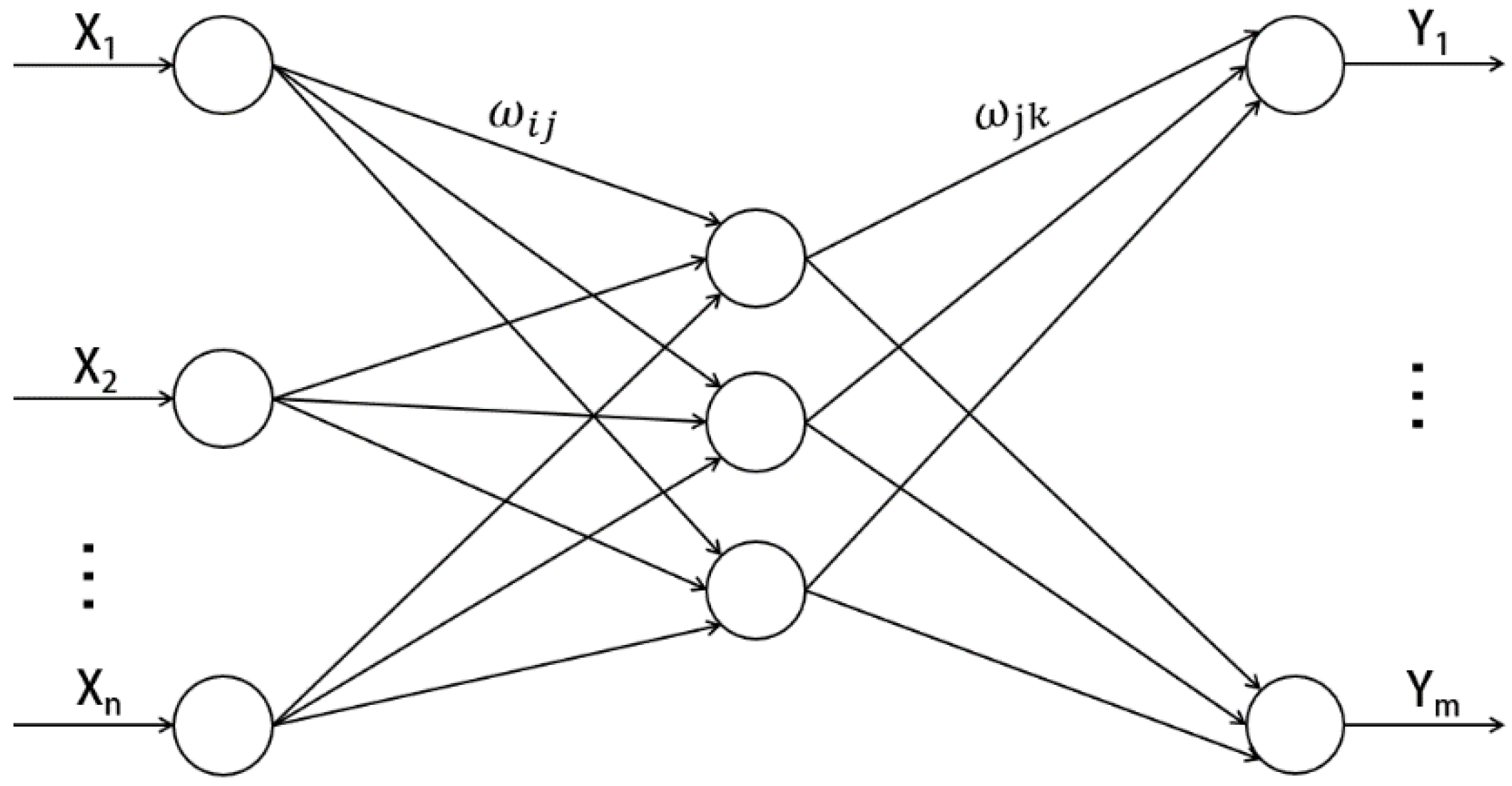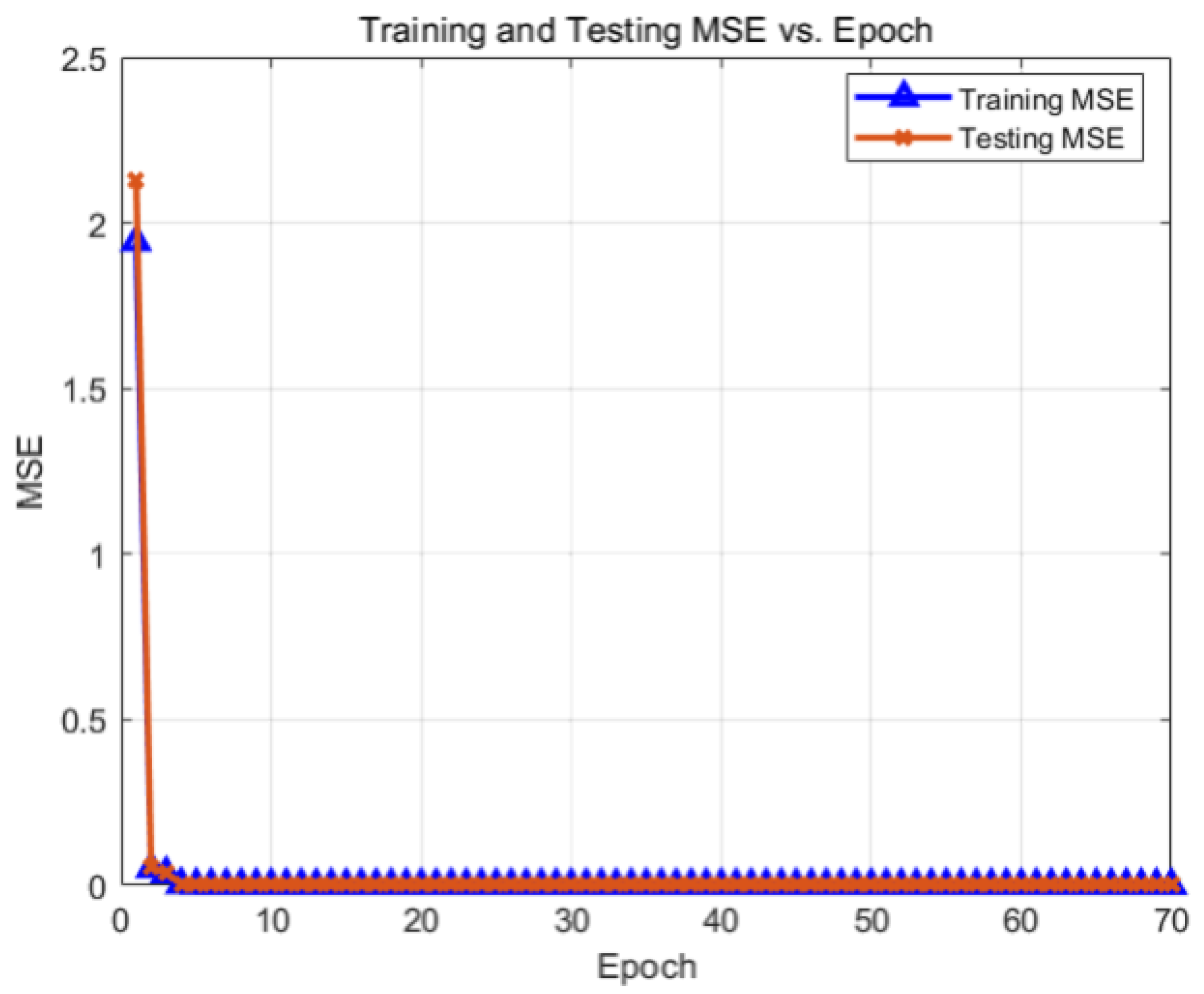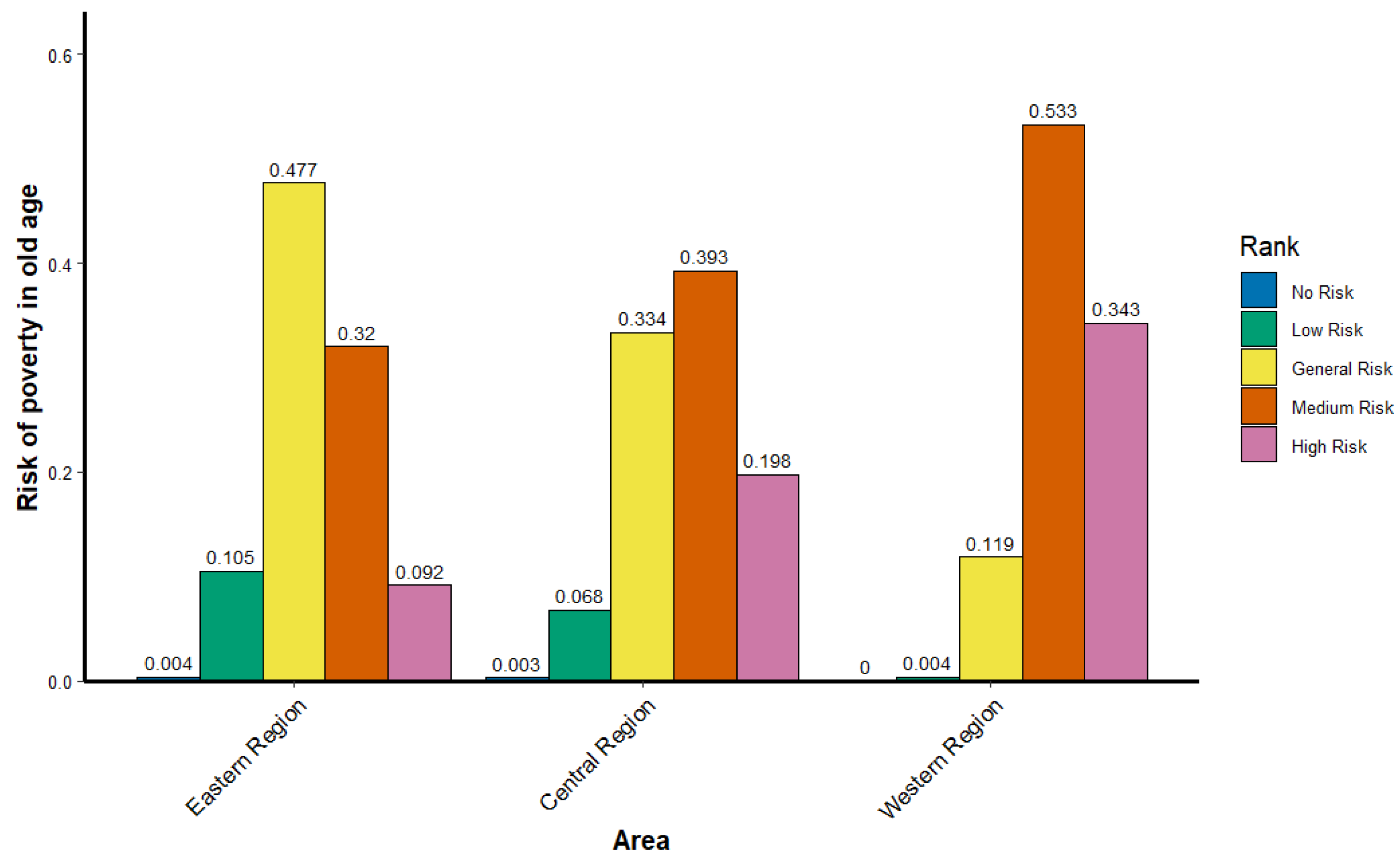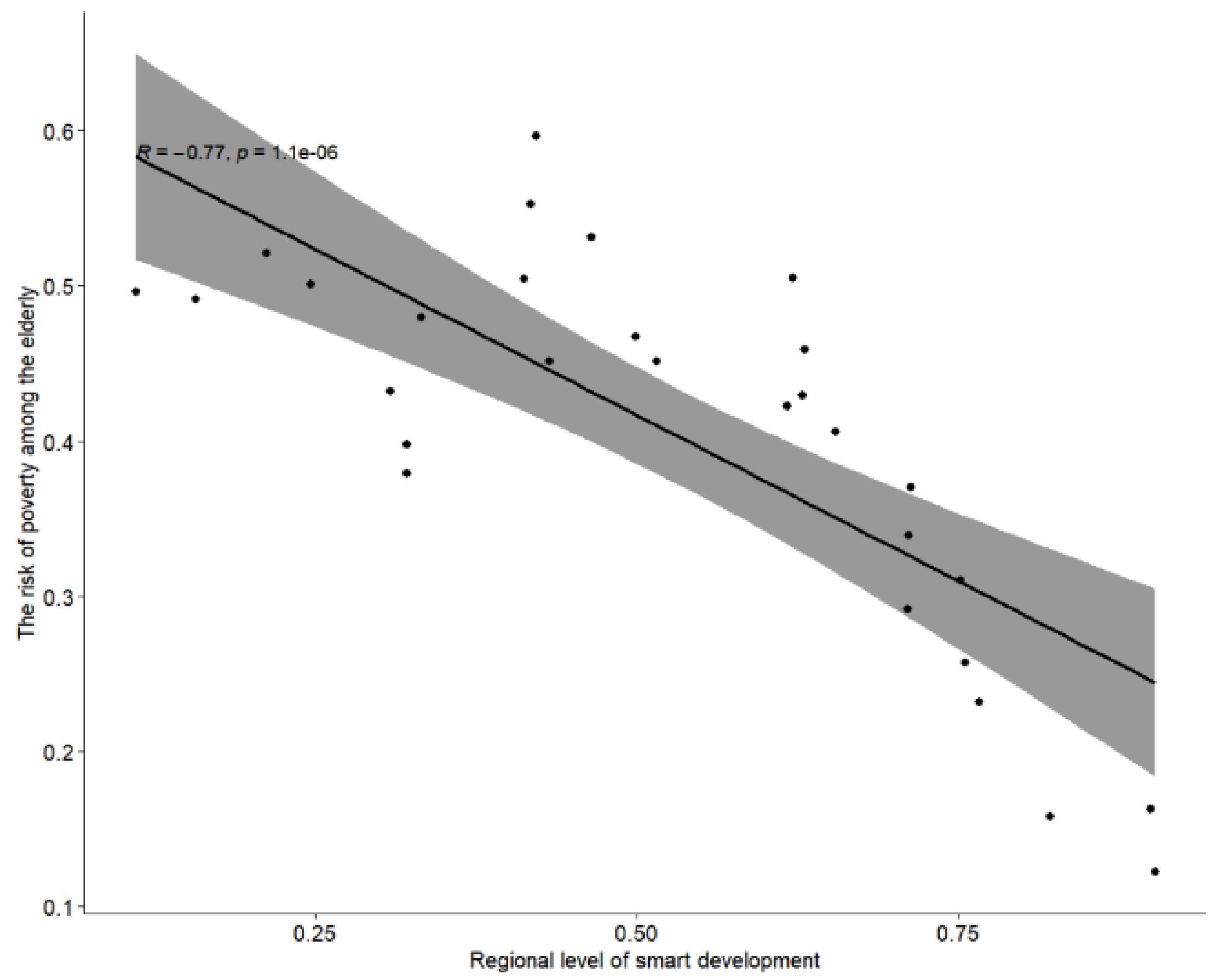Impact Analysis of Regional Smart Development on the Risk of Poverty among the Elderly
Abstract
1. Introduction
2. Literature Review and Research Hypothesis
3. Data Sources and Evaluation Indicator System
3.1. Data Sources and Processing
3.2. Evaluation Method Selection
3.3. Evaluation Index System Construction and Result Analysis
3.4. Regional Smart Level Evaluation Index System
4. Effect of Regional Smart Development on the Risk of Poverty in Old Age
4.1. Model Construction
4.2. Regression Analysis
4.3. Endogeneity Discussion
4.4. Robustness Test
4.5. Heterogeneity Test
5. Conclusions and Suggestions
5.1. Research Conclusions
5.2. Relevant Suggestion
5.3. Possible in-Depth Research in the Future
Supplementary Materials
Author Contributions
Funding
Institutional Review Board Statement
Informed Consent Statement
Data Availability Statement
Conflicts of Interest
References
- Caria, S.A.; Falco, P. Does the Risk of Poverty Reduce Happiness? Econ. Dev. Cult. Chang. 2018, 67, 1–28. [Google Scholar] [CrossRef]
- Packard, T.G. Pooling, Savings and Prevention: Mitigating the Risk of Old Age Poverty in Chile. Policy Research Working Paper Series. 2002. Available online: https://elibrary.worldbank.org/doi/abs/10.1596/1813-9450-2849 (accessed on 21 May 2002).
- Chen YR, R.; Schulz, P.J. The Effect of Information Communication Technology Interventions on Reducing Social Isolation in the Elderly: A Systematic Review. J. Med. Internet Res. 2016, 18, e18. [Google Scholar] [CrossRef] [PubMed]
- Oparaocha, G.O. Towards building internal social network architecture that drives innovation: A social exchange theory perspective. J. Knowl. Manag. 2016, 20, 534–556. [Google Scholar] [CrossRef]
- Elder, G.H., Jr. The life course as developmental theory. Child Dev. 1998, 69, 1–12. [Google Scholar] [CrossRef] [PubMed]
- Börsch-Supan, A.; Kneip, T.; Litwin, H.; Myck, M.; Weber, G. 1 SHARE: A European policy device for inclusive ageing societies. Ageing Eur. -Support. Policies Incl. Soc. 2015, 1–22. [Google Scholar] [CrossRef][Green Version]
- Stephan, K.; Tobias, L.; Felix, P. A feminization of vulnerability? Female headship, poverty, and vulnerability in Thailand and Vietnam. World Dev. 2015, 71, 36–53. [Google Scholar]
- Haveman, R.; Holden, K.; Wilson, K.; Wolfe, B. Social security, age of retirement, and economic well-being: Intertemporal and Demographic patterns among retired-worker beneficiaries. Demography 2003, 40, 369–394. [Google Scholar] [CrossRef] [PubMed]
- Storper, M.; Manville, M. Behaviour, Preferences and Cities: Urban Theory and Urban Resurgence. Urban Stud. 2006, 43, 1247–1274. [Google Scholar] [CrossRef]
- Bachofner, Y.; Seifert, A.; Sepahniya, S.; Fabian, C. Exploring online health information seeking and sharing among older adults: A mini-review about acceptance, potentials, and barriers. Front. Digit. Health 2024, 6, 1336430. [Google Scholar] [CrossRef]
- Xiao, C.; Patrician, P.A.; Montgomery, A.P.; Wang, Y.; Jablonski, R.; Markaki, A. Filial piety and older adult caregiving among Chinese and Chinese-American families in the United States: A concept analysis. BMC Nurs. 2024, 23, 115. [Google Scholar] [CrossRef]
- Uchino, B.N.; Cacioppo, J.T.; Kiecolt-Glaser, J.K. The relationship between social support and physiological processes: A review with emphasis on underlying mechanisms and implications for health. Psychol. Bull. 1996, 119, 488–531. [Google Scholar] [CrossRef] [PubMed]
- Hedström, G.; Hagberg, O.; Jerkeman, M.; Enblad, G.; Swedish Lymphoma Study Group. The impact of age on survival of diffuse large B-cell lymphoma—A population-based study. Acta Oncol. 2015, 48, 736–745. [Google Scholar] [CrossRef] [PubMed]
- Zhou, F.; Tian, C.C.; Xu, J.L.; Wei, J. Water quality assessment of the river network in Wenzhou city using PCA-BP neural network model. IOP Conf. Ser. Earth Environ. Sci. 2020, 612, 012018. [Google Scholar] [CrossRef]
- Li, Y. Designing the System of Real Estate Rent Appraisal Based on BP Neural Network. Chin. J. Manag. Sci. 2002, 10, 23–27. [Google Scholar]
- Barrientos, A.; Gorman, M.; Heslop, A. Old Age Poverty in Developing Countries: Contributions and Dependence in Later Life. World Dev. 2003, 31, 555–570. [Google Scholar] [CrossRef]
- Li, Z.; Li, G.; Zhang, K.; Zhu, J. Do Social Pension and Family Support Affect Farmers’ Land Transfer? Evidence from China. Land 2022, 11, 497. [Google Scholar] [CrossRef]
- Ebbinghaus, B. Inequalities and poverty risks in old age across Europe: The double-edged income effect of pension systems. Soc. Policy Adm. 2023, 10, 440–455. [Google Scholar] [CrossRef]
- Scullys, T.; Cohen, K. An Investigation into a Neural Network’s performance based on the Number of Neurons in the Hidden Layer. In Proceedings of the Aiaa Applied Aerodynamics Conference, San Francisco, CA, USA, 6–8 June 2006. [Google Scholar]
- Wang, Z.B.; Sun, T.S.; Zhang, J.F. Regional Types’ Division of Population Aging and Analysis on Population Aging Regional Evolution: Based on China, America, Japan and R O Korea. Sci. Geogr. Sin. 2015, 35, 822–830. [Google Scholar]
- Giffinger, R.; Fertner, C.; Kramar, H.; Kalasek, R.; Pichler-Milanovic, N.; Meijers, E.J. Smart Cities. Ranking of European Medium-Sized Cities; Final Report; Vienna University of Technology: Vienna, Austria, 2007. [Google Scholar]
- Eger, J.M. Smart growth, smart cities, and the crisis at the pump a worldwide phenomenon. I-WAYS-J. EGovernment Policy Regul. 2009, 32, 47–53. [Google Scholar] [CrossRef]
- Shi, H.; Tsai, S.B.; Lin, X.; Zhang, T. How to evaluate smart cities’ construction? A comparison of Chinese smart city evaluation methods based on PSF. Sustainability 2017, 10, 37. [Google Scholar] [CrossRef]
- Zanobetti, A.; Redline, S.; Schwartz, J.; Rosen, D.; Patel, S.; O’Connor, G.T.; Lebowitz, M.; Coull, B.A.; Gold, D.R. Associations of PM10 with sleep and sleep-disordered breathing in adults from seven U.S. urban areas. Am. J. Respir. Crit. Care Med. 2010, 182, 819. [Google Scholar] [CrossRef] [PubMed]
- Wang, W.; Khelfaoui, I.; Ahmed, D.; Xie, Y.; Hafeez, M.; Meskher, H. Nexus between information and communication technologies and life expectancies of low-income countries: Does technological advancement increase their life span? SS -Popul. Health 2024, 25, 101600. [Google Scholar] [CrossRef] [PubMed]
- Yu, C.; Yu, J.; Gao, D. Smart Cities and Greener Futures: Evidence from a Quasi-Natural Experiment in China’s Smart City Construction. Sustainability 2024, 16, 929. [Google Scholar] [CrossRef]
- Shariatpour, F.; Behzadfar, M.; Zareei, F. Urban 3D Modeling as a Precursor of City Information Modeling and Digital Twin for Smart City Era: A Case Study of the Narmak Neighborhood of Tehran City, Iran. J. Urban Plan. Dev. 2024, 150, 04024005. [Google Scholar] [CrossRef]
- Chatri, A.; Tahir, N. How do COVID-19 re-hiring subsidies affect unemployment duration and incomes in Morocco? An instrumental variable approach. J. Econ. Struct. 2023, 12, 19. [Google Scholar]
- Sun, Z.; Du, L.; Long, H. Regional Heterogeneity Analysis of Residential Electricity Consumption in Chinese Cities: Based on Spatial Measurement Models. Energies 2023, 16, 7859. [Google Scholar] [CrossRef]
- Eyler, A.A.; Brownson, R.C.; Donatelle, R.J.; King, A.C.; Brown, D.; Sallis, J.F. Physical activity social support and middle- and older-age minority women: Results from a U.S. survey. Soc. Sci. Med. 1999, 49, 781–789. [Google Scholar] [CrossRef]




| Layer | Index | Direction | Weight Coefficient |
|---|---|---|---|
| Economic risk | All kinds of subsidies to after-tax monthly income | (-) | 0.120 |
| Difference in household transfers | (-) | 0.105 | |
| Total medical expenditure | (+) | 0.105 | |
| Psychological risk | Degree of loneliness | (+) | 0.094 |
| Degree of happiness | (-) | 0.094 | |
| Individual risk | Degree of health | (-) | 0.091 |
| Level of intelligence | (-) | 0.063 | |
| Family risk | Have a family to live with | (-) | 0.049 |
| Level of family care input | (-) | 0.014 | |
| Social risks | Social welfare | (-) | 0.105 |
| Awareness of social issues | (+) | 0.082 | |
| Social connections | (-) | 0.079 |
| Layer | Primary Index | Secondary Index |
|---|---|---|
| Smart technology | Foundation of technology | (X1) Number of Internet users per 100 people (X2) The overall level of Internet development |
| Ability to innovate | (X3) Technology market turnover (X4) Digital economy patent application data | |
| Smart ecology | Environmental condition | (X5) Technology market turnover (X6) Digital economy patent application data |
| Ecological response | (X7) Harmless treatment rate of household garbage (X8) Daily treatment capacity of urban sewage (X9) Area of afforestation in the current year | |
| Smart human capital | Education and cultivation | (X10) The intensity of R&D investment (X11) The proportion of education expenditure in the general budget of local finance |
| Human capital | (X12) Persons employed in urban units in scientific research and technology services (X13) Persons employed in urban units in information transmission, software, and information technology services | |
| Smart economy | Vitality of economic development | (X14) Digital inclusive financial index (X15) Gross product (X16) Revenue from information technology services |
| Green development | (X17) Energy consumption per unit GDP (X18) Green finance index | |
| Income level of residents | (X19) Per capita disposable income of permanent urban residents | |
| Smart governance | Urban governance | (X20) Proportion of information security revenue (X21) Local fiscal expenditure on public security (X22) Investment in environmental pollution control in GDP |
| Government service | (X23) Coverage of social service institutions | |
| Smart people’s livelihood | Medical conditions | (X24) Number of beds in medical and health institutions (X25) Consumer price index of medical services per 10,000 population |
| Construction of culture | (X26) The number of public library collections per capita (X27) The number of public library institutions | |
| Infrastructure construction | (X28) The level of urban infrastructure (X29) The number of bus-electric vehicles in operation (X30) Highway density | |
| Social security | (X31) Income from basic endowment insurance fund (X32) Income from urban basic medical insurance fund (X33) Number of people participating in unemployment insurance | |
| People’s happiness | (X34) Provincial crime rate (X35) Registered urban unemployment rate |
| Year | Region | Intelligent Level | Smart Technology | Smart Ecology | Smart Human Capital | Smart Economy | Smart Governance | Smart People’s Livelihood |
|---|---|---|---|---|---|---|---|---|
| 2018 | Nationwide | 0.393 | 0.361 | 0.660 | 0.224 | 0.314 | 0.375 | 0.418 |
| Eastern region | 0.525 | 0.555 | 0.760 | 0.356 | 0.467 | 0.459 | 0.532 | |
| Central region | 0.339 | 0.285 | 0.646 | 0.163 | 0.256 | 0.264 | 0.418 | |
| Western region | 0.302 | 0.222 | 0.571 | 0.136 | 0.204 | 0.373 | 0.303 | |
| 2020 | Nationwide | 0.434 | 0.462 | 0.635 | 0.295 | 0.348 | 0.440 | 0.425 |
| Eastern region | 0.560 | 0.657 | 0.753 | 0.462 | 0.517 | 0.454 | 0.518 | |
| Central region | 0.384 | 0.379 | 0.602 | 0.210 | 0.282 | 0.383 | 0.450 | |
| Western region | 0.345 | 0.327 | 0.541 | 0.190 | 0.228 | 0.468 | 0.314 |
| Variable | Model (1) | Model (2) | Model (3) | Model (4) | Model (5) | Model (6) | Model (7) |
|---|---|---|---|---|---|---|---|
| The Elderly | The Elderly | The Elderly in the High Age Group | The Elderly in the Low Age Group | Eastern Region | Central Region | Western Region | |
| Intelligent level | −2.153 *** | −0.244 *** | −0.170 ** | −1.018 ** | −0.345 *** | −0.743 *** | 0.117 ** |
| Urban and rural areas | −0.013 * | −0.009 * | 0.007 | 0.001 | 0.014 | 0.013 | |
| Sex | 0.020 ** | 0.014 ** | 0.037 * | 0.009 * | −0.005 | 0.005 * | |
| Level of education | −0.016 *** | −0.017 *** | −0.026 ** | −0.008 * | 0.012 ** | −0.018 ** | |
| Age | −0.048 *** | −0.048 *** | −0.046 *** | −0.057 *** | −0.033 *** | −0.032 *** | |
| Retirement Security | −0.040 *** | −0.004 * | −0.029 ** | −0.003 | 0.014 | −0.011 | |
| Marital status | 0.018 | 0.039 | −0.032 | 0.023 | 0.016 | 0.010 | |
| Intergenerational relations | −0.005 ** | −0.005 * | −0.022 *** | −0.007 * | −0.005 | −0.001 | |
| Constant | 1.611 *** | 3.998 *** | 3.920 *** | 4.787 *** | 4.274 *** | 3.190 *** | 3.356 *** |
| Individual fixed effects | Controlled | Controlled | Controlled | Controlled | Controlled | Controlled | Controlled |
| Value of observation | 4090 | 4090 | 3531 | 559 | 1830 | 1268 | 992 |
| R2 | 0.262 | 0.366 | 0.367 | 0.421 | 0.329 | 0.389 | 0.453 |
| (1) | (2) | (3) | |
|---|---|---|---|
| Level of Intelligent Development | Risk of Poverty among Older Persons | Fixed Effect Model | |
| IV | 0.115 *** | ||
| RIL | −0.153 *** | −0.244 *** | |
| Urban and rural areas | 0.009 *** | −0.007 | −0.013 * |
| Sex | 0.003 | 0.016 *** | 0.020 ** |
| Level of education | −0.003 | −0.015 *** | −0.016 *** |
| Age | 0.000 | 0.000 | −0.048 *** |
| Retirement Security | −0.005 | −0.034 *** | −0.040 *** |
| Marital status | −0.007 * | 0.017 ** | 0.018 |
| Intergenerational relations | −0.001 | −0.020 *** | −0.005 ** |
| Constant | −0.938 *** | 0.680 *** | 3.998 *** |
| Wald test | 204.64 | ||
| F | 1070.55 | ||
| P | 0.0000 | ||
| Individual fixed effects | Controlled | Controlled | Controlled |
| Value of observation | 4090 | 4090 | 4090 |
| R2 | 0.690 | 0.245 | 0.366 |
| Variable | Risk of Poverty among Older Persons | Family Financial Situation | |
|---|---|---|---|
| Model (1) | Model (2) | Model (3) | |
| RIL | 0.011 ** | ||
| The comprehensive development level of the Internet | −0.442 ** | ||
| Basic network construction | −0.008 *** | ||
| Variable of control | YES | YES | YES |
| Individual fixed effects | Controlled | Controlled | Controlled |
| Value of observation | 4090 | 4090 | 4090 |
| R2 | 0.366 | 0.372 | 0.762 |
| Variable | (1) | (2) | (3) |
|---|---|---|---|
| Eastern Region | Central Region | Western Region | |
| RIL | −0.345 *** | −0.743 *** | 0.117 ** |
| Variable of control | YES | YES | YES |
| Individual fixed effects | Controlled | Controlled | Controlled |
| Constant | 4.274 *** | 3.190 *** | 3.356 *** |
| Value of observation | 1830 | 1268 | 992 |
| R2 | 0.329 | 0.389 | 0.453 |
| Variable | (1) | (2) | (3) | (4) | (5) | (6) |
|---|---|---|---|---|---|---|
| Receive Financial Support | No Financial Support Is Received | Receive Care Support | No Care Support | Have Social Insurance | No Social Insurance | |
| RIL | −0.496 ** | 0.585 ** | −0.293 ** | 0.413 * | −0.234 ** | −0.218 |
| Variable of control | YES | YES | YES | YES | YES | YES |
| Individual fixed effects | Controlled | Controlled | Controlled | Controlled | Controlled | Controlled |
| Constant | 3.712 *** | 3.897 *** | 3.899 *** | 3.732 *** | 3.857 *** | 5.461 *** |
| Value of observation | 2325 | 1765 | 1620 | 2470 | 3538 | 552 |
| R2 | 0.360 | 0.345 | 0.348 | 0.367 | 0.350 | 0.462 |
Disclaimer/Publisher’s Note: The statements, opinions and data contained in all publications are solely those of the individual author(s) and contributor(s) and not of MDPI and/or the editor(s). MDPI and/or the editor(s) disclaim responsibility for any injury to people or property resulting from any ideas, methods, instructions or products referred to in the content. |
© 2024 by the authors. Licensee MDPI, Basel, Switzerland. This article is an open access article distributed under the terms and conditions of the Creative Commons Attribution (CC BY) license (https://creativecommons.org/licenses/by/4.0/).
Share and Cite
Luo, C.; Li, H.; Song, L. Impact Analysis of Regional Smart Development on the Risk of Poverty among the Elderly. Sustainability 2024, 16, 3094. https://doi.org/10.3390/su16073094
Luo C, Li H, Song L. Impact Analysis of Regional Smart Development on the Risk of Poverty among the Elderly. Sustainability. 2024; 16(7):3094. https://doi.org/10.3390/su16073094
Chicago/Turabian StyleLuo, Chunyang, Hongmei Li, and Lisha Song. 2024. "Impact Analysis of Regional Smart Development on the Risk of Poverty among the Elderly" Sustainability 16, no. 7: 3094. https://doi.org/10.3390/su16073094
APA StyleLuo, C., Li, H., & Song, L. (2024). Impact Analysis of Regional Smart Development on the Risk of Poverty among the Elderly. Sustainability, 16(7), 3094. https://doi.org/10.3390/su16073094





